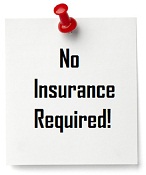
Whenever you read an article about mandatory auto insurance, the writer will usually say something like “virtually all states require you to buy insurance” or that “practically all states require drivers to be insured.” That’s because, while the vast majority of states do require their residents to purchase car coverage, states like Virginia, South Carolina, and new Hampshire do not place such requirements on drivers. There is a catch, though.
In New Hampshire, drivers still have to be financially responsible, meaning they must prove that they have the means to pay for all damages that they cause while behind the wheel of an automobile. And the vast majority of New Hampshirites do so by purchasing insurance.
In Virginia and South Carolina, drivers can legally be on the road uninsured, but they’ll have to pay what’s known as an uninsured motorist fee. Virginia’s fee is $500, and South Carolina’s fee is $550. In both cases, the revenues go to an uninsured motorist fund that is used to help lower the cost of uninsured motorist insurance for drivers who do purchase coverage.
South Carolina has been allowing drivers to legally get on the road without coverage by paying the fee since February 1999, according to the state’s DMV. However, not all South Carolina drivers will be able to go without coverage. Every driver in the car owner’s household must have been licensed for three or more years, and car owners who have to file an SR-22 with the state are not eligible.
In Virginia, 2,425 drivers in fiscal year 2011 paid the uninsured motorist fee, according to the Virginia DMV. Since there were more than 7.8 million vehicles registered during that year, that means only 1 in about every 3,220 cars were on the road without coverage legally.
Uninsured Virginians thinking about skipping the cost of the uninsured fee should think again. If they get caught doing so, they’ll have their driver’s license, registration, and license plates suspended, will have to pay the $500 uninsured motorist fee that they didn’t pay earlier, and will have to file an SR-22, meaning they will have to buy coverage for the next three years and prove to the state that they have done so.
While the prospect of getting rid of that monthly premium bill might be enticing, motorists who decide to pay the uninsured motorist fee and drive without coverage are exposing themselves to the possibility of financial ruin. If they cause serious damage in an accident, they are still responsible for having to pay for those damages. That means they could be on the hook for hundreds to hundreds of thousands of dollars’ worth of damages after a crash that they’ve caused. With that in mind, the wisest decision would probably be to look around for a cheap policy online and get covered rather than go uninsured.